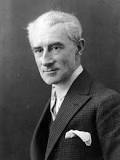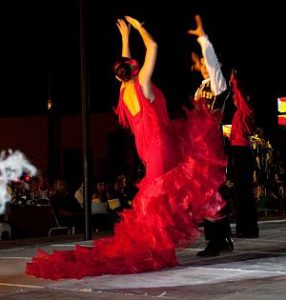But first, the Paraprosdokian of the week —
If you can smile when things go wrong, you have someone in mind to blame.
Yesterday, I was about fifteen minutes from home when I turned on Sirius radio and was fortunate to hear the opening bars of Ravel’s Bolero. I immediately slowed down, not wanting to arrive before the dramatic finish of the piece.
Maurice Ravel wrote the piece at the request of the Russian actress and dancer Ida  Rubinstein. It premiered at the Paris Opera in November 1928—as a musical selection, with no dance—and, to Ravel’s surprise, was an immediate success. It was reported that he said, “I had written a piece lasting seventeen minutes and consisting wholly of ‘orchestral tissue without music’ — of one very long, gradual crescendo. There are no contrasts, and practically no invention except the plan and the manner of execution.”
Rubinstein. It premiered at the Paris Opera in November 1928—as a musical selection, with no dance—and, to Ravel’s surprise, was an immediate success. It was reported that he said, “I had written a piece lasting seventeen minutes and consisting wholly of ‘orchestral tissue without music’ — of one very long, gradual crescendo. There are no contrasts, and practically no invention except the plan and the manner of execution.”
But in spite of the composer’s downplay of the piece, it became his most famous work. When Conductor Arturo Toscanini conducted the US premier in 1929, it received shouts and cheers from the audience and a standing ovation.
There are some who say it is too repetitious, monotonous, and uninspired. They are missing the true genius of the Bolero. Ravel created two memorable themes, and then used them to create interest and tension. Yes, the main theme is repeated eighteen times, but with many different instruments picking up this theme with diverse orchestration. At one point, the first theme is played in one key while the second theme is being played in a different key. The piece starts out softly pianissimo and rises in a continuous crescendo to fortissimo possible (very loud). Ravel embellished the themes, altered the presentation, added drama, so that the Bolero leads the listener – propels the listener – to the powerful and dramatic conclusion.
The result is a piece that is dramatic, sensual, powerful. Memorable. Exciting.
While it was originally written for a dancer, it is rarely preformed to  accompany a dance. An exception to this is a group of young dancers in Puerto Vallarta, Mexico, the Xiutla Folkloric Dance Group. For its one thousandth performance, famous Spanish dancer Luis Montero was asked to choreograph a dance to The Bolero. He produced a dance that captures of drama and excitement of Ravel’s piece. The group has now preformed this dance many times and it never fails to bring the audience to its feet, cheering, clapping, and asking when the group will perform the dance again so they may attend.
accompany a dance. An exception to this is a group of young dancers in Puerto Vallarta, Mexico, the Xiutla Folkloric Dance Group. For its one thousandth performance, famous Spanish dancer Luis Montero was asked to choreograph a dance to The Bolero. He produced a dance that captures of drama and excitement of Ravel’s piece. The group has now preformed this dance many times and it never fails to bring the audience to its feet, cheering, clapping, and asking when the group will perform the dance again so they may attend.
I arrived home before the end of the piece, so I just sat in the car to hear the striking finish. I was not disappointed. That’s part of the power of music. You can hear a piece many times, but the repetition doesn’t diminish the pleasure, the excitement.
Ravel understood that.
If you have listened to the Bolero, give us your thoughts on the music. Thanks.
James R. Callan, 2016

Oh. I forgot to say that the picture in the blog of the dancers is from one of the Xiutla performances in Puerto Vallarta. And the exquisite performance comes from young adults – maybe 18 – 21 years old. Amazing.
I, too, love Bolero. I had a copy of it in graduate school and I played it over and over. I guess I was hoping that was the way my graduate experience would be like-beginning softly and ending in a crescendo. The music was much better!
And probably graduation day was the climax. And the dance these young kids do is fantastic. Of course, Montero’s choreography helps. But that added to the music and the costumes and the drama – it becomes emotional for me. Thanks for visiting, Lesley.
My brother (four years older than I) introduced me to classical music at a very young age. When I was in the third grade, our music teacher (yes, music was a regular subject back then.) had us write our favorite song on a piece of paper and turn it in. Every paper but mine said “The Green Door” (I wonder what’s behind the green door) You’re probably too young to remember that one. Mine read: “Bolero.” Of course all the other kids considered me strange, but the teacher appreciated me. Thanks for the reminder. I hadn’t heard it in years. But I checked U-Tube and found it. What a pleasure (and rush of sweet memories) to hear it again.
See, older brothers are good for something. And I’m so glad you found it and experienced it again. Thanks for stopping by.
Ah…my all-time-life-time favorite piece. The memories it brings back cannot be written. But this much I will tell. Picture a handsome young man and his beautiful new wife. Now picture a bedroom with an ancient Victrola sitting near the bedside. Only one record sits on the turntable. Ravel’s dashing piece; Bolero. This is how I learned about love.
Well, that would make it special music, for sure. Thanks for visiting, and for giving us just a tiny insight into how special you find Ravel’s Bolero.
Thanks for stopping by, Gay. You’d love this performance of the dancers. I’ve seen it a number of times and it still move me. Great stuff. Thanks for the comment.
Just about my favorite piece of music to listen to – it never fails to stir and move me. I, too, must pause in whatever I’m doing when I have the good fortune of it playing on the classical music radio station I listen to. I once had a CD of it and wore it out as I worked at my computer.